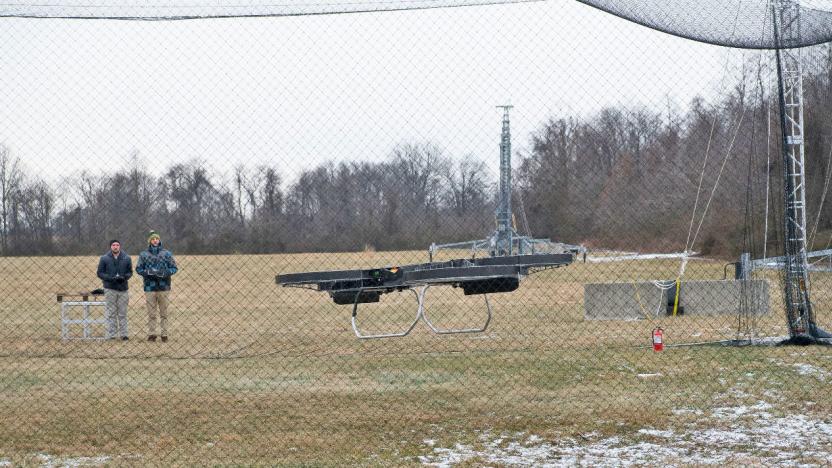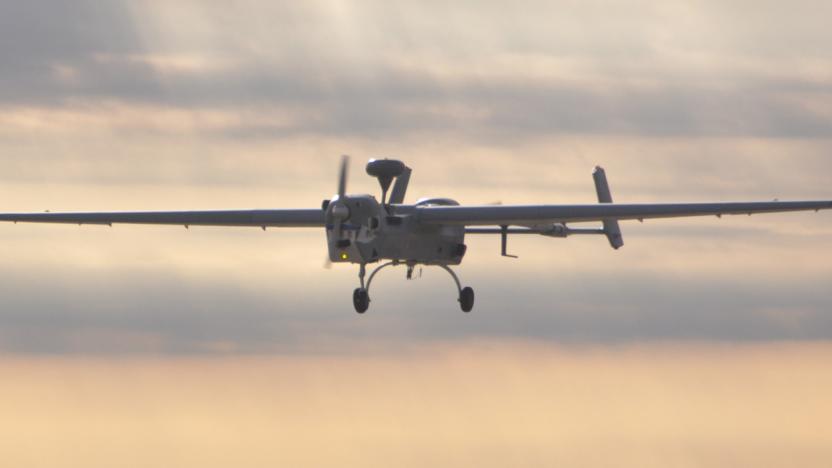usarmy
Latest

Air Force enlists hackers to hunt bugs in its site
Bug bounties have been a staple among startups and online businesses since the days of Netscape Navigator but the federal government has been slow to adopt the beneficial code hunts. However, a year after the DoD's first such program, Hack The Pentagon, the Air Force announced on Wednesday that it will be hosting one of its own next month.

Toy drones don't stand a chance against a $3 million missile
A Patriot missile costs around $3 million. A commercial quadcopter? Let's say roughly $200. But which one would win on the battlefield? General David Perkins, Commander of the US Army Training and Doctrine Command, knows the answer to this hypothetical David and Goliath match-up -- because it's already happened. During a military symposium, he touched on a strike made by a US ally, where the consumer drone "did not stand a chance" against the twenty-year old missile. With all due respect, sir, we could have told you that.

US Army looking to resupply troops via mortar bombardment
The US Army is working on a new means of rapidly resupplying its troops using hollowed out artillery shells. The system, while still in its concept phase, could eventually help deliver critical ammunition and medical equipment to its forces, even in the middle of a firefight.

ICYMI: The U.S. Army is making actual hover bikes
try{document.getElementById("aol-cms-player-1").style.display="none";}catch(e){}Today on In Case You Missed It: The Galactic Empire will have some competition for Speeder Bikes soon enough, from the US Army. Researchers there have been working on hoverbikes for a few years now, based on an Australian inventor's design. Make sure to watch the video of the temperatures stacking up each year, bringing us to the hottest recorded weather for 2016, or a video of the sunspot twice as big as Earth. As always, please share any interesting tech or science videos you find by using the #ICYMI hashtag on Twitter for @mskerryd.

The US Army successfully flies its hoverbike prototype
The Army has proven that the hoverbike its contractors are developing actually works during a flight demo with the Department of Defense. Dr. William Roper, director of the Strategic Capabilities Office for the Secretary of Defense, watched the large rectangular prototype quadcopter take off at the Aberdeen Proving Ground in Maryland on January 10th. The hoverbike began as a Kickstarter project by creator Malloy Aeronautics. Once Malloy secured a contract with the military, it teamed up with defense company Survice Engineering Co. to continue the bike's development. It has since become a joint project between the Army and the US Marine Corps.

US Army wants bullets that turn into plants over time
The US military may not seem like the greenest of organizations, but if rising seas and temperatures produce worldwide chaos, they're the ones that have to deal with that shit. Now, the Department of Defense is trying to tackle environmental problems caused by spent bullets and casings on its firing ranges by using composite materials laced with seeds.

US Army's 'Phaser' could fry entire drone swarms in a volley
While the US military has enjoyed several decades of aerial dominance with few enemy fighter planes to shoot down, the emergence of ISIS drones presents a new threat to American ground troops. To combat swarms of these cheap, small dangers, the US Army is testing a new anti-air device that is designed to blow multiple UAVs out of the sky in a single shot. They call it the Phaser.

US Army's smart earplugs spare soldiers from loud noises
As you might imagine, soldiers can't just use garden variety earplugs to protect their ears. It might tone down the sounds of explosions and gunshots, but it'll also prevent them from hearing a crucial command or an enemy on the other side of a doorway. It's less of an issue for the US Army these days, though. The military branch has been gradually rolling out a smart earplug, TCAPS (Tactical Communication and Protective System), that adapts to the audio realities of war. The smartphone-linked device softens louder noises, but amplifies quieter ones; if your squad leader needs to issue a command, you'll hear it over the din of battle.

ICYMI: Robots, disappearing medical skin and more
#fivemin-widget-blogsmith-image-336110{display:none;} .cke_show_borders #fivemin-widget-blogsmith-image-336110, #postcontentcontainer #fivemin-widget-blogsmith-image-336110{width:570px;display:block;} try{document.getElementById("fivemin-widget-blogsmith-image-336110").style.display="none";}catch(e){}Today on In Case You Missed It: We are rounding up a few interesting robot and car stories at the top of the show because simply too much happened since last week to just chose one. The University of North Texas drug-sniffing car needs a mention, and so does the US Army's new bomb bot. Also, researchers from MIT developed a gel that dries as a totally clear second skin. It could be used to do something as simple as smooth out wrinkles (see ya, botox!) or deliver topical medicine, covertly. And Harvard's Wyss Institute came up with a cheap way to test for the Zika virus; hopefully at-risk states take notice. If you like Rube Goldberg devices, this one with magnets and marbles might blow your mind. As always, please share any great tech or science videos you find by using the #ICYMI hashtag on Twitter for @mskerryd.

US Army hopes to outfit soldiers with tiny drones by 2018
American soldiers should soon get drone support beyond just big, expensive machines flying well above the battlefield. The US Army has requested industry information on the feasibility of making tiny drones (Soldier Borne Sensors in official lingo) that would help infantry gather intelligence on a small scale, such as peeping over a hill or around a building. Its dream recon machine would weigh no more than a third of a pound, launch within one minute and fly for at least 15 minutes. Ideally, the drones would be in service as soon as 2018.

US Army patents bullet that self-destructs to protect civilians
The .50 caliber bullet is one of the biggest projectiles you can fit in a rifle or machine gun. Its size and range makes it super-effective at neutralizing foes over long distances, but because it also takes a lot to stop, it can still harm or kill innocent bystanders. Maybe that's why the US Army has patented a new "limited range projectile" that self-destructs as it reaches its target.

Helicopter and six-wheeler make a mean, crewless recon team
Why send humans into dangerous territory when you can send unmanned helicopters and six-wheelers instead? In an impressive mashup of autonomous transportation, Carnegie Mellon University (CMU) and aircraft manufacturer Sikorsky have shown the two vehicles working together without on-board operators. During the demonstration, a modified Black Hawk helicopter picks up a chunky Land Tamer with a large cage, before flying 12 miles and releasing it at a designated drop-zone. The ground vehicle then navigates the leafy terrain for six miles, with a remote driver occasionally chipping in to explore particularly hazardous sites.

ICYMI: DARPA Bots doing chores, VR fight action and more
#fivemin-widget-blogsmith-image-293926{display:none;} .cke_show_borders #fivemin-widget-blogsmith-image-293926, #postcontentcontainer #fivemin-widget-blogsmith-image-293926{width:570px;display:block;} try{document.getElementById("fivemin-widget-blogsmith-image-293926").style.display="none";}catch(e){}Today on In Case You Missed It: A team that placed in the most recent DARPA challenge is still testing its robot, only now the tasks are more house-related. The IHMC has found that they can best tell whether their bot is responding well to new software by seeing how it handles common chores around the garage.

Government testing smart parachutes that stay on target
GPS is not foolproof -- especially on the modern battlefield, where electronic warfare systems can interfere with the satellite guidance. And when packages miss their mark, soldiers often have to venture into hostile territory to retrieve them. That's why the US Army is developing a joint precision airdrop system, or JPADS, that guides equipment towards its target using only visual cues.

US Army retires its first drone
Military drones may still seem like relatively fresh concepts, but they're officially old hat as of this month: the US Army has retired its first-ever drone, IAI's Hunter, after 20 (!) years of service. The robotic recon veteran will now see use only through government-owned contractor support units. The troops, meanwhile, will upgrade to the General Atomics Gray Eagle, which boasts better sensors on top of greater endurance (25 hours instead of 12) and a higher altitude ceiling (29,000 feet versus 15,000).

ICYMI: Smartest lights yet, robots on the farm and more
#fivemin-widget-blogsmith-image-433187{display:none;} .cke_show_borders #fivemin-widget-blogsmith-image-433187, #postcontentcontainer #fivemin-widget-blogsmith-image-433187{width:570px;display:block;}try{document.getElementById("fivemin-widget-blogsmith-image-433187").style.display="none";}catch(e){}Today on In Case You Missed It: BeOn Home has made smart lightbulbs that recognize noises like a doorbell or fire alarm and turn on accordingly. A robot designed to check fertilizer levels and smash weeds should help the average family farmer one day. And the US Army is checking its soldier's brain waves to understand what part of an image captures their attention.

US Army lab develops a way to read soldiers' brains
Military intelligence analysts spend a lot of time scrutinizing countless images from various sources, such as drones and surveillance systems. An automated program developed by cognitive neuroscientist Dr. Anthony Ries, however, can make the process a lot faster. Ries works for a US Army research facility called the "The MIND (Mission Impact Through Neurotechnology Design) Lab," which has just began testing a program that can interpret brain waves. In simpler words: it can read human minds. During a recent test, he hooked up a soldier to an EEG connected to one of the lab's desktop computers and asked him to look at a series of images on screen flashing at a rate of one per second. Each image falls under one of five categories -- boats, pandas, strawberries, butterflies and chandeliers.

Runaway blimp prompts the US to freeze a missile defense program
That US Army radar blimp that ran amok didn't just trigger an internet frenzy... it may have put the brakes on a big military research initiative. Pentagon officials have frozen the JLENS (Joint Land Attack Cruise Missile Defense Elevated Netted Sensor System) program behind the blimp while they investigate what went wrong. The government isn't saying what it might do, but there are already politicians calling for the blimps to be cut. JLENS had already been hanging by a thread ever since 2010, when the Army threatened to kill it -- there are longstanding concerns about both the technology's reliability and its effectiveness compared to conventional aircraft. Don't be surprised if these defensive dirigibles vanish in short order. [Image credit: U.S. Air Force/Tiffany DeNault via Getty Images]

The US Army lost control of a radar blimp
It's the runaway llamas all over again... in airborne form. One of the US Army's missile-detecting radar blimps broke off its tether in Maryland, creating havoc both in the skies (the Air Force even sent fighter jets to track it) and among the many, many internet users following its every move. It eventually drifted over Pennsylvania, and there are reports that it knocked out power lines at a school in the state before coming down. We're still waiting to know the blimp's health, but it's safe to say that the Army will be more than a little red-faced as it looks into what went wrong.

ICYMI: Latest grenade launcher, modular smart watch and more
#fivemin-widget-blogsmith-image-332561{display:none;} .cke_show_borders #fivemin-widget-blogsmith-image-332561, #postcontentcontainer #fivemin-widget-blogsmith-image-332561{width:570px;display:block;} try{document.getElementById("fivemin-widget-blogsmith-image-332561").style.display="none";}catch(e){}Today on In Case You Missed It: The U.S. Army is more interested than ever in blowing things up with precision, and that's why it's beginning acceptance testing on a smart grenade launcher that can detonate explosives mid-air. The rest of us can get our geek on with the Kickstarter for Blocks modular watch, which has different modules for all kinds of things: Advanced fitness tracking, mobile payments or GPS. And a Kickstarter to house jellyfish in the fanciest way possible is up for a hefty $1,500.








